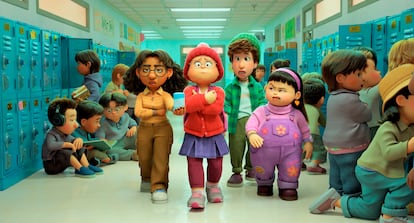‘Turning Red’: Pixar’s taboo-busting period film leaves some men complaining about representation
The film is the studio’s first to be directed, written and produced by women, and finds a witty metaphor for puberty. But not everyone gets it

The well-known YouTuber Sean Chandler struggled to say it directly. “I really think Turning Red is going to be Pixar’s most polarizing film. Based on most Twitter reactions and it’s [sic] initial RT [Rotten Tomatoes] score, lots of people are loving it. But there’s a handful of us which it really rubbed the wrong way,” he tweeted. “Pixar usually makes films w/ broad appeal. Turning Red is intentionally niche,” he added in another post.
What is alienating and niche about a Toronto girl who sometimes turns into a red panda? What makes it “weird,” as this popular movie critic has said? Well, it’s all about how the film’s protagonist, Meilin, or Mei Mei to her family, gets her period.
Director Domee Shi and co-writer Julia Cho have come up with an apt metaphor to describe the discombobulating experience of becoming a teenager and the accompanying changes that happen to one’s body. Mei Mei is 13 years old and lives in Toronto in 2002. She is a model only child in a family of Chinese origin. She gets straight A’s in school, plays the flute in the band, has a gang of rather nerdy friends, and when she finishes her classes, she comes home to help her parents run the temple they dedicate to their ancestors. Her mother fits the Asian-American stereotype of the “Tiger Mom:” a righteous, unrelenting woman who holds her daughter up as a kind of blueprint for excellence. All that changes the day Mei Mei wakes up transformed into a red panda. Suddenly she is a wild creature. She smells funny. Her mood swings are unpredictable. She can’t control her emotions. She likes boys. She doesn’t like her mother. And she needs, nay, absolutely MUST go see her favorite boy band, 4*Town. The band’s songs in the film, by the way, were written by singer Billie Eilish and her brother Finneas O’Connell.
The first Pixar film to be solely directed by a woman – Shi is also responsible for the award-winning short Bao – has a 95% score on Rotten Tomatoes, with only light criticism from some corners like Maya Philips of the New York Times, who wondered whether its portrayal of Asian women is representation or stereotype. But there are also male voices who simply don’t get it, who all express themselves in similar terms: “This is not what Pixar usually does. I only see a very small group of people capable of understanding this film,” notes one audience reviewer.
The critic Sean O’Connell wrote a widely condemned review for CinemaBlend where he criticized the film for its lack of universal themes. “I recognized the humor in the film, but connected with none of it. By rooting Turning Red very specifically in the Asian community of Toronto, the film legitimately feels like it was made for Domee Shi’s friends and immediate family members. Which is fine… but also, a tad limiting in its scope.” The review was later pulled while O’Connell doubled down on Twitter: “Some Pixar films are made for universal audiences. Turning Red is not. The target audience for this one feels very specific and very narrow. If you are in it, this might work very well for you. I am not in it. This was exhausting.”

The backlash was immediate: “Turning Red is a coming of age story that literally anybody can relate to. It’s about a teen growing up, starting to explore their independence & the awkwardness/challenges that come with that phase in their lives. So many of us have lived through that,” tweeted the new site POC Culture. “This is what happens when white males are presented as the default. Audiences have empathized w/ white male protagonists forever but you get one Asian girl in animation & these people question their existence. #TurningRed.” O’Connell, who is also the managing director of CinemaBlend, has since apologized.
The controversy in particular centers on the portrayal of non-white characters, but it is striking how some reviewers are unable to understand a film about a girl whose red peony has bloomed, as Meilin’s mother poetically puts it. For something that is so close for much of its audience, rival animation studio Disney has long shied away from the issue of puberty and its complications. The recent film Luca was a departure in some ways, by exploring the mismatch that occurs when two friends grow up at different speeds. A ten-minute Disney short called The Story of Menstruation was produced for the Kimberly-Clark Company in 1946 and aired in schools. But other than that, no one ever thought to allude to the hormonal changes of Mulan, Moana or Merida from Brave.
Audiences have empathized with white male protagonists forever but you get one Asian girl in animation and these people question their existencePOC Culture
In Pixar’s Turning Red, periods are always at the heart of the film, starting with the title, as one of the producers, Lindsey Collins, explained to Polygon magazine: “It was always in the very earliest versions of the film. It was the first thing we put into production,” she said. “Everybody on the crew was unapologetic in support of having these real conversations about periods and about these moments in girls’ lives.” She admits that both she and the director feared the reaction of Pixar executives, but they discovered their fears were unfounded. “I think they saw it very much in the DNA of the film and the characters,” Collins said. “The hope is with putting it on the screen and having it be something that is cringy, but also funny, and a part of this story, it does normalize it.”
The studio, which has undergone a shakeup following the departure of its founder, John Lasseter, over sexual harassment allegations in 2017, once had a serious problem with female characters and certainly with the number of women working on its films. In 2012, screenwriter and animator Brenda Chapman developed the story of Brave, about a Scottish heiress who doesn’t want to be a princess and accidentally turns her mother into a bear. It’s not unreasonable to think that the Turning Red team is paying homage to her with their red panda. However, the studio fired her as director and put Mark Andrews as co-director in the credits. Chapman explained the effect this had on her in an article in The New York Times. “This was a story that I created, which came from a very personal place, as a woman and a mother. To have it taken away and given to someone else, and a man at that, was truly distressing on so many levels,” she wrote.
“Animation used to be mostly dudes,” Lasseter himself said in 2015, and it mostly still is. Only 26% of people working in animation in the US are women, according to a study by job search website Zippia. It has taken a film from the largest animation studio to have a female director, female producer and female screenwriter for the first time for a film to talk about periods. For some, women’s visibility can only be interpreted as their own marginalization.
Tu suscripción se está usando en otro dispositivo
¿Quieres añadir otro usuario a tu suscripción?
Si continúas leyendo en este dispositivo, no se podrá leer en el otro.
FlechaTu suscripción se está usando en otro dispositivo y solo puedes acceder a EL PAÍS desde un dispositivo a la vez.
Si quieres compartir tu cuenta, cambia tu suscripción a la modalidad Premium, así podrás añadir otro usuario. Cada uno accederá con su propia cuenta de email, lo que os permitirá personalizar vuestra experiencia en EL PAÍS.
¿Tienes una suscripción de empresa? Accede aquí para contratar más cuentas.
En el caso de no saber quién está usando tu cuenta, te recomendamos cambiar tu contraseña aquí.
Si decides continuar compartiendo tu cuenta, este mensaje se mostrará en tu dispositivo y en el de la otra persona que está usando tu cuenta de forma indefinida, afectando a tu experiencia de lectura. Puedes consultar aquí los términos y condiciones de la suscripción digital.
More information
Últimas noticias
The metaverse, four years later: Is it finished or just at a standstill?
$3,000 and a plane ticket: The United States increases incentives for migrants to self-deport before the end of the year
Charles Dubouloz, mountaineering star, retires at 36 with a farewell tour inspired by Walter Bonatti
From the White House to diplomatic gifts: Lego wins over adult fans, brick by brick
Most viewed
- The low-cost creative revolution: How technology is making art accessible to everyone
- Christian Louboutin: ‘Young people don’t want to be like their parents. And if their parents wear sneakers, they’re going to look for something else’
- All the effects of gentrification in one corner of Mexico’s Colonia Roma
- Christmas loses its festive spirit: ICE fears cast shadow over religious celebrations
- Liset Menéndez de la Prida, neuroscientist: ‘It’s not normal to constantly seek pleasure; it’s important to be bored, to be calm’










































